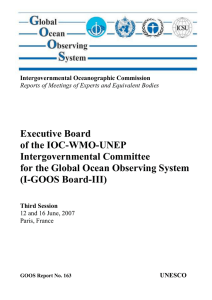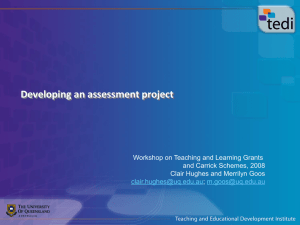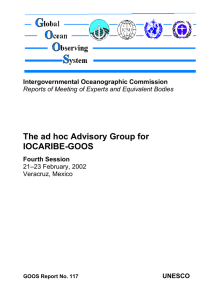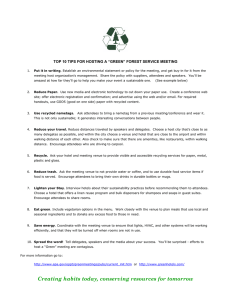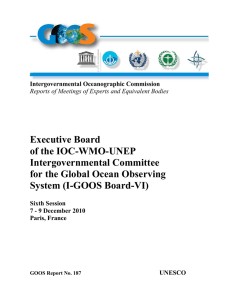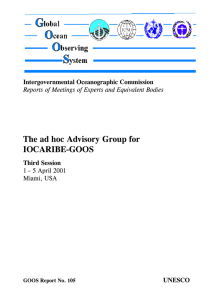The Global Ocean Observing System (GOOS) Regional Groups: A Discussion Paper
advertisement
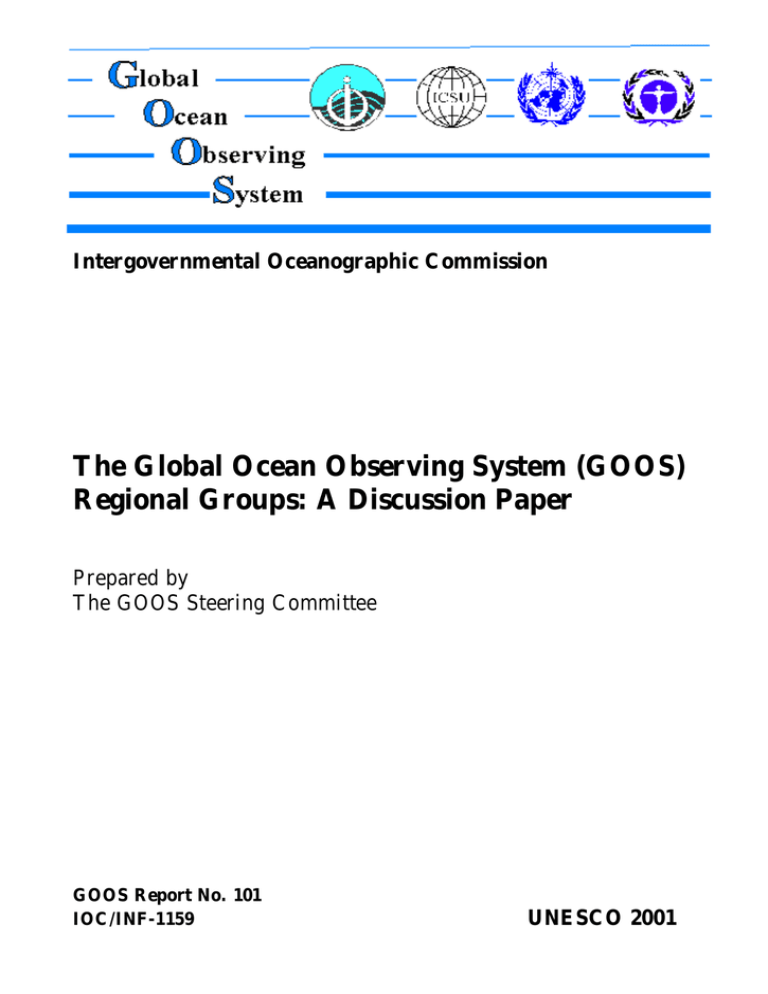
Intergovernmental Oceanographic Commission The Global Ocean Observing System (GOOS) Regional Groups: A Discussion Paper Prepared by The GOOS Steering Committee GOOS Report No. 101 IOC/INF-1159 UNESCO 2001 Intergovernmental Oceanographic Commission The Global Ocean Observing System (GOOS) Regional Groups: A Discussion Paper Prepared by The GOOS Steering Committee GOOS Report No. 101 IOC/INF-1159 UNESCO 2001 IOC/INF-1159 Paris, April 2001 English only ABSTRACT GOOS will be implemented by Member States operating at the national level, and, where appropriate, in partnership with neighbours at the regional level, and in partnership with other Member States at the global level. In recent years there has been a rapid growth in the number of groups of Member States or their agencies expressing interest in taking the responsibility for the regional development of GOOS, beginning in the mid 1990s with EuroGOOS in Europe, and NEARGOOS in the North East Asian Region. Such growth is both reasonable and desirable. In order to ensure that it happens in the most effective way, and without duplication of effort or arguments over boundary issues, a policy is needed to cover regional GOOS development. To assist in the development of a regional policy by the Intergovernmental Committee for GOOS (I-GOOS), the GOOS Steering Committee has prepared this discussion paper, which sets out the issues, the present state of play, and the options for the future. SC/2001/WS/19 IOC/INF-1159 page (i) TABLE OF CONTENTS SUMMARY Page 1. INTRODUCTION.............................................................................................................. 1 2. NATIONAL LEVEL ........................................................................................................... 1 3. THE NATURE AND SIZE OF REGIONS ........................................................................... 2 4. DEFINITION OF THE BOUNDARIES OF REGIONS ........................................................ 3 5. PROCEDURE FOR RECOGNIZING GOOS REGIONS ..................................................... 3 6. ASSESSMENT OF PRESENT REGIONAL SITUATION.................................................... 4 7. INTERNATIONAL CO-ORDINATION.............................................................................. 6 8. FINAL REMARKS ............................................................................................................ 6 ANNEXES I. THE ROLE OF NATIONAL GOOS CO-ORDINATING COMMITTEES II. LIST OF ACRONYMS IOC/INF-1159 1. INTRODUCTION At the second session of the GOOS Steering Committee (GSC-II, Beijing, 26-29 April, 1999), it was recognized that the development of GOOS through regional alliances is accelerating. These regional alliances may be composed of nations or of national agencies - here we refer to the members as nations. This development was viewed as natural and desirable. However, it also was recognized that the development of regional units is fraught with the potential for overlap with other existing regional organizations, duplication of effort, inefficient use of resources, and conflicts. The potential for confusion and conflict is great in the development of regional GOOS groupings of nations. Recognition of groups claiming or intending to develop a regional GOOS must be carefully considered, both as regards boundaries and the technical capabilities of the proposing, parent organization. Therefore, it was agreed at GSC-II that there must be a policy for regional GOOS development. To assist in the development of a regional policy by the Intergovernmental Committee for GOOS (I-GOOS), a small group prepared a discussion paper which was considered at GSC-III (Paris, 10-12 May 2000). Following that meeting, this document was prepared. It is the intention that the I-GOOS will approve a GOOS Regional Policy at its June 2001 meeting. This document first considers the operational units of GOOS, beginning with the fundamental unit - the national contribution. Then the rationale for and possible numbers of GOOS regional groups are discussed followed by some suggestions for the definition of regional boundaries. Requirements which must be met by GOOS regional groups are suggested as a procedure for recognizing GOOS regions. Quite a number of GOOS regional groups are operational, emerging, or being considered. A brief assessment of the present situation is presented. The last section gives some overview as final remarks. 2. NATIONAL LEVEL To understand why regional organization is needed at all, it is necessary to start by considering the national level. The operational unit is the contribution of the Member State to GOOS. This is itself composite, consisting of contributions from a variety of government agencies, research laboratories, universities, industries, and non-governmental organizations. Those nations with a good internal co-ordination will be in the best position to make a valuable contribution to the implementation of GOOS, as well as to obtain the most benefit from it. In the context of GOOS implementation, it is important to stress the strong co-ordination needed at the national level. Some nations are so large, and have such an extensive oceanic coastline, that alone they effectively form a region which is a logical component on the global scale. Probably Australia, India and the USA are in this category. Russian Federation and China have different requirements because they locally interface with semi-enclosed seas, demanding multi-nation collaboration at the regional scale. There are 128 Member States in IOC. The majority can be assumed to have some role in implementing GOOS and in benefiting from it. The Initial GOOS Commitments Meeting, in Paris in July 1999, was attended essentially by the OECD nations plus Russia, China, Chile, and Brazil. On that basis, it seems likely that some 25 to 30 of the richest nations in the world, backed by the various national and multi-national space agencies and consortia, are going to contribute most of the input to GOOS. Most of these nations were able to report some form of interagency collaboration to develop GOOS within their national administrations, and many of them reported their membership within a GOOS region, principally NEAR-GOOS, EuroGOOS, and MedGOOS. We can assume that another 20 or 30 nations with modest and growing economies will be active participants in GOOS, although they may not contribute much more to the system than what they need locally. Finally, there are a large number of nations in the developing category whose net contribution to the system in technological terms will necessarily be small. However, participation in GOOS would be of great benefit to many of these nations, and access to their sea area and offshore islands would facilitate GOOS implementation. Clearly, working with these nations to build capacity to participate in and benefit from GOOS is a priority. IOC/INF-1159 page 2 Co-ordination of the implementation activities of national agencies and promotion of GOOS at the national level is deemed most desirable through National GOOS Co-ordinating Committees (NGCCs). The role of NGCCs as specified by the 2nd session of the GOOS Steering Committee and the 4th session of the Intergovernmental Committee for GOOS is given in Annex I. These National Committees will bring together representatives of all major stakeholders (central government, local government, academia, industry, and nongovernmental organizations). That will usually make them different from the National Oceanographic Committees (NOCs) promoted over the years by the IOC. There is a fundamental difference between the two in the sense that NOCs were primarily devised to encourage the co-ordination of research, whereas NGCCs are designed to encourage the co-ordination of operational oceanography and marine meteorology. However, the two are not mutually exclusive, and should as far as possible be combined or connected, not least because the IOC has evolved to take on operational oceanography as a central part of its mandate. In future the NOC structure will have to adapt to this evolution and to meet the requirements of JCOMM, the new Joint WMO/IOC Technical Commission for Oceanography and Marine Meteorology, which deals with operational oceanography as well as marine meteorology. NGCCs meet the need for the co-ordination required for JCOMM. 3. THE NATURE AND SIZE OF REGIONS There are about 180 states in the United Nations, and nearly 130 in the IOC. All the UN agency activities related to the sea find it necessary to develop regional scales intermediate between the national and the global. The numbers of regions for these agencies are: FAO: UNEP: IOC: WMO: IHO: World Bank: 35 regions (global coverage); 14 regions (not global coverage); 7 regions (not global coverage); 6 regions (global coverage); and sea area names over 100 regions (global coverage); 50 Large Marine Ecosystem areas. There are at least three potential reasons for setting up regional structures: (i) To reduce the administrative complexity of trying to administer/co-ordinate programmes in each nation (120 say) from a head office in Paris or Geneva. By logically grouping nations into clumps of from 3-4 to a maximum of 10-20 the total number of units required to cover the globe can be reduced to between 20 and 50. (ii) To group those nations that are geographical neighbours, and have common political, commercial, or social interests. Thus, the European nations may wish to work together-or the African nations or the South American nations. Note that FAO has regions which are continental, and others which are oceanic; the continental regions are designed to administer inland and freshwater fisheries rather than political units. Of course, a nation may be a member of both its continental block and the adjacent oceanic region. GOOS has requirements for similar groupings. (iii) To provide scientific, technical, and logistic collaboration in a sea area, where separate endeavours by individual states would be less effective and efficient, or even impossible. The smaller regions where this reason is relevant are such areas as the Baltic, Adriatic, or Japan seas. At the oceanic level, it is relevant on the scale of the North Atlantic or the South Pacific. It should be noted that this reason may result in a grouping of nations surrounding the sea area of interest, but it may also result in a grouping of nations from various parts of the globe united in a common purpose. Examples of the latter include the operating nations of the ENSO observing system in the equatorial Pacific, or of a pilot project such as PIRATA, focused on the tropical Atlantic. The driving logic for GOOS regional development should derive from reason 3. Reasons 1 and 2 may follow from this. A comparison with other UN agencies suggests that GOOS might eventually have between 30 and 50 permanent regions covering the whole globe. IOC/INF-1159 page 3 In addition, however, there may exist at any given time other groupings of nations focused on Projects and Programmes for the purpose of testing and operating elements of the global observing system. These may be focused (i) on regions and types of observations (e.g., ICES and PICES may wish to test the ecosystem approach to fisheries management in the context of GOOS), (ii) on a narrow range of observations (e.g., the proposed Sea Keepers association making measurements from private yachts), or on a product (e.g., the ENSO observing system). It is not our purpose to circumscribe groupings of the latter type. 4. DEFINITION OF THE BOUNDARIES OF REGIONS The definitive rationale for the designation of GOOS regions and their boundaries is the need to monitor, model, and predict seawater bodies which can be treated as physical or biological units. It does not make sense to model one half of the North Sea or of the Gulf of Mexico. Some UN agency systems of nomenclature and regions tend to divide the oceans in half, so that you have a North East Atlantic, a North West Atlantic, etc. GOOS is more logically defined in terms of nested regions of different scales. There is no contradiction in having a North Atlantic region, which contains within its model boundaries a northwest European shelf region or a USA Atlantic seaboard region. Similarly, there could be a Mediterranean region containing an Adriatic or Aegean sub-region. A requirement of nomenclature is that the boundaries of named sea areas should be consistent with the nomenclature approved by the UN (DOALOS) or an appropriate UN Agency (such as IMO). FAO already recognizes both continental regions and oceanic regions, and a coastal state can therefore belong to a region of each type if situated appropriately geographically. Likewise, it is natural that GOOS should have regions that overlap in purview the same body of sea water, such as EuroGOOS, a Mediterranean GOOS, and an Africa GOOS sharing interests in the Mediterranean Sea. Moreover, a coastal state may belong to more than one region. For that reason, it is necessary that distinct lines of responsibility and clear lines of coordination be established. 5. PROCEDURE FOR RECOGNIZING GOOS REGIONS (i) GOOS policy, developed by I-GOOS, with advice from the GSC and the GOOS Project Office (GPO), must strike a cautious balance between encouraging the development of regional bodies within a general overall strategy, and the excessive promotion or early recognition of groups which do not have the authority or expertise to develop or implement GOOS. Other reasons for delaying the recognition of a regional group might be the inappropriate size of the region (too small or too large), or the existence of a distinct group also claiming to be in a position to implement GOOS in the same region. (ii) Any regional organization being set up to implement GOOS must comply with the GOOS principles and strategy as published by the IOC in GOOS Report No.41 (see GOOS Web Site at http://IOC.UNESCO.org/GOOS). (iii) There are already numerous ways in which scientific projects can be developed in a region, as well as existing channels for technical aid and assistance. For many years the UNEP Regional Seas Programme, FAO, UNDP, and other bodies have existed to provide resources for development of economic and social benefit. A new GOOS regional organization should be recognized only if it will add something genuinely new and valuable to this existing pattern. The new feature must contribute to the integrated, sustained, end-to-end system from observations to products. GOOS is a tool to produce information from observations, and this function should be prominent in regional GOOS planning. (iv) GOOS must embrace initiatives concerned with information needed by participating nations and organizations from local to global in scale. At the regional and sub-regional levels, the observations and data processing conducted in operational oceanography are likely to focus mainly on site-specific variables, and to be processed in such a way as to produce high-resolution products of principally, or wholly, local interest. From the point of view of coastal states, this high resolution, customized IOC/INF-1159 page 4 products are likely to be of the greatest value. At the opposite end of the time and space scales, there will be GOOS products which are describing decadal processes on a global scale. We must define participation in GOOS, and recognition of regional and sub-regional activities, to include observing system elements that provide for all scales of needed information. Politicians and funding agencies must perceive GOOS as concerned with the variables and scales that will provide the information of highest economic concern to the nation and region involved in the system. (v) As with all GOOS activities, it is expected that data from regional activities shall be available for use by outside parties, even if the data are not distributed globally in real time. In recognizing regional GOOS activities it may be advisable to acknowledge that data and products from such activities differ from the truly global data sets, and to recognize them as regional or sub-regional in nature. By contributing to a global data and information management system each participating region also plays an integral role in establishing the global network. (vi) Because GOOS was created as an intergovernmental mechanism, it might be expected that in due course regional groups would become intergovernmental. Experience shows that at an early stage in implementing GOOS regionally, the first steps take place at the level of national agencies. As GOOS becomes incorporated into national infrastructures by agencies, it seems likely that regional GOOS bodies will increasingly become the subject of intergovernmental agreements. Bearing this evolutionary process in mind, and seeking to encourage regional GOOS development, regional GOOS alliances are encouraged to adopt whatever organizational framework that is acceptable to them. An alliance may be comprised of, or organized as, a group of national governments, a group of state agencies, an international organization that acts on the behalf of a group of nations, or some other group of empowered entities. (vii) Regions will be relied upon to take the initiative and organize resources required to gain a high profile for their regional GOOS activities. To facilitate regional development and implementation it is likely that each regional group will need a small secretariat. The international GOOS Project Office located within the IOC in Paris may be able to assist such regional secretariats in developing resources. 6. ASSESSMENT OF PRESENT REGIONAL SITUATION There are a number of regional GOOS groupings in existence; these range in development from new to well developed and operational. In addition, there are conceptual and nascent groups, some of which will come into formal existence. Listed here are some of these, along with their geographic relationship to other UN regional groupings. NEAR-GOOS and EuroGOOS exist and have several years of experience, with many lessons learned. MedGOOS, Black Sea GOOS, and IOCARIBE-GOOS were created more recently, but have been formally recognized by IOC and have held their first meetings. There is sufficient local infrastructure and experience to be fairly sure that operational observations and modelling will develop to good professional standards in each region. (i) NEAR-GOOS is part of the IOC’s regional sub-commission for the western Pacific (WESTPAC), and maps onto the North West Pacific Action Plan of the UNEP Regional Seas Programme. (ii) MedGOOS maps onto the IOC’s integrated Mediterranean programme, which includes activities like MedGLOSS, and onto the Mediterranean Action Plan of the UNEP Regional Seas Programme. (iii) Black Sea GOOS maps onto the IOC’s Black Sea Regional Committee and UNEP’s Black Sea Environmental Programme. (iv) IOCARIBE-GOOS is part of the IOC’s sub-commission for the Caribbean (IOCARIBE), and maps onto UNEP’s Caribbean Environment programme. IOC/INF-1159 page 5 (v) EuroGOOS has five main regional activities: • • • • • A Baltic Operational Oceanographic System (BOOS), which maps onto the Helsinki Commission (HELCOM), which pre-dates UNEP’s Regional Seas Programme; a Mediterranean task force, which contributes to but is independent from MedGOOS; an Arctic task force (see xii, below); a Northwest shelf Operational Oceanographic System (NOOS), covering the North Sea and adjacent areas, which maps onto the Oslo/Paris Commission (OSPARCOM), which pre-dates UNEP’s Regional Seas Programme; an Atlantic regional task force. (vi) GOOS-AFRICA has held its first meeting at Maputo in July 1998. This was very successful. There are logical reasons for keeping the nations together as a continental unit, while at the same time recognizing the importance of four or more different oceanic areas of operation: Mediterranean Sea, Red Sea, Indian Ocean, and Atlantic. GOOS-AFRICA is charged with aiding development in these regions. A West African margin GOOS could map onto the IOC’s Central Eastern Atlantic (IOCEA) region, and onto UNEP’s West and Central African Region. An east African GOOS could map onto the IOC’s north and central western Indian Ocean (IOCINCWIO) region (see vii below). (vii) There is interest in developing GOOS in the Indian Ocean. This has been stimulated by a meeting of western Indian Ocean coastal and island countries who planned the Western Indian Ocean Marine Applications Project (WIOMAP), which is yet to be funded. WIOMAP is developing under the aegis of WMO and IOC and is regarded as a GOOS pilot project in embryo. It would map onto UNEP’s Eastern African region. With Australian support the IOC has created a Regional Programme Office for GOOS in Perth, Western Australia, one object of which is to assist with regional GOOS developments in the Indian Ocean. (viii) There is interest in GOOS dispersed over many of the island states of the South Pacific. These nations have agreed to form a Pacific GOOS, which had its first implementation workshop in Apia in August 2000. The political significance of this grouping is high, especially as some of the small island states are seriously threatened by rising global sea level. PacificGOOS maps onto UNEP’s South Pacific Regional Environment Programme (SPREP). (ix) The nations on the west coast of South America are developing collaborative programmes within the framework of plans for the coastal elements of GOOS. Their design includes a set of nested scales, entirely consistent with GOOS strategy. No official regional proposal yet exists, but this activity likely will continue to develop, possibly with the aid of the Permanent Commission for the South Pacific (CPPS), an independent organization entrusted by UNEP with the implementation of the regional Convention and Action Plan for the south-east Pacific, and which has a Memorandum of Agreement with the IOC. Several delegates to I-GOOS-IV mentioned their aspirations to create a South American continental GOOS association. There are no official proposals yet. However, plans are being developed for a regional programme office for GOOS in Rio de Janeiro. (x) There is a very strong logical requirement for a government-based observing system throughout Southeast Asia that would provide the public domain infrastructure and large scale of observations needed to support the many commercial networks and local agency observations in the region. The WMO and IOC have worked with countries in the region to gain acceptance for the concept of a SouthEast Asia Centre for Atmospheric and Marine Prediction (SEACAMP). Aspects of the proposal for SEACAMP are under consideration by the ASEAN organization. SEACAMP would provide a possible pilot project for a southeast Asia GOOS (SEA-GOOS). At present it is not clear where the leadership for SEA-GOOS would lie, nor whether it should comprise one large region or several smaller ones. Its development is under consideration in the IOC's WESTPAC. SEAGOOS would overlap with UNEP’s East Asian and South Asian Seas Action Plans. (xi) A proposal for an Arctic GOOS was discussed informally at the Initial GOOS Commitments Meeting and was well received by the delegates present. Such a regional operational system could build on IOC/INF-1159 page 6 many pre-existing science and monitoring programmes. It also has the appropriate geographical scale and logical relation to the coastal states. EuroGOOS already has an Arctic task force considering the needs for Arctic observations and products. 7. INTERNATIONAL CO-ORDINATION It is essential that good co-ordination and communication exist between the national GOOS Coordinating Committees, the regional GOOS bodies, and the international co-ordinating mechanisms provided by the GOOS Steering Committee, I-GOOS, and the GOOS Project Office. The national and regional bodies should follow the same strategy, operate within the same principles, adhere to the same standards, and exchange data and information using the same mechanisms. 8. FINAL REMARKS (i) There is a strong logical argument for implementing GOOS through a combination of national, regional, and global scale institutional structures. The driving reason for multinational structures should be to provide scientific, technical, and logistic collaboration in a sea area, where separate endeavours by individual states would be less effective and efficient, or even impossible. Often this will involve a water mass the physical and biological dynamics of which need to be studied and managed as an integral unit. GOOS regions should be based wherever possible on geographical groupings of nations with a common interest and a wish to work together. (ii) Regional GOOS groups are encouraged provided they meet reasonable criteria. To implement those observing system elements that will provide needed information on regional and sub-regional scales, GOOS regional activities will be essential. (iii) Several regional groupings already either have been formed or are being discussed as possible GOOS regions. (iv) Most of the developed or incipient GOOS regions identified thus far seem to have an appropriate scale and membership, with a reasonable chance of implementing operational ocean observations and services, although progress is at very different rates. (v) The ad hoc formation of GOOS regions so far has been carried out with no formal procedure for recognition of a region; with no specification for the minimum criteria for a region; and no format for the relations between regions, between regions and the GOOS Project Office, or between regions and the GOOS module panels. These defaults need to be corrected, but without creating so much bureaucracy that it becomes impossible to form any new regions. (vi) In spite of the lack of a formal approach, most of the GOOS regional groups do map onto IOC regions and/or UNEP Regional Seas areas. Regional subsidiary bodies of the IOC, and perhaps of UNEP and other sponsors as well, have a part to play in facilitating GOOS. They could help facilitate the formation of regional groupings and could embrace regional GOOS activities within their purview in co-ordinating with global activities. (vii) Regional GOOS groups should provide regular reports to the GOOS governing bodies (GSC and IGOOS), so as to facilitate international co-ordination and the harmonious implementation of GOOS. (viii) The Module Panels of GOOS may provide assistance or advice to regional GOOS groups. (ix) Regions should share experiences on identifying the benefits of GOOS, and transfer experience between themselves where relevant. IOC/INF-1159 page 7 (x) (xi) (xii) Because of regional differences in the development of infrastructure, pre-existing regional bodies, and local levels of scientific and operational systems, regions may concentrate on different components of marine science, observational strategy, operational systems, and value added. This discussion paper on regional GOOS development has been prepared by the GOOS Steering Committee with assistance from its panels and associates, including the I-GOOS chair and the Director of the GOOS Project Office. A draft GOOS Regional Policy document will be offered for consideration, modification, and approval at I-GOOS V (June 2001). It is expected that regional groups seeking recognition as part of GOOS would contact the GOOS Project Office. Requests would be considered by the GOOS Steering Committee and recommendations made to the I-GOOS, where final decisions as to recognition would be made. IOC/INF-1159 Annex I ANNEX I THE ROLE OF NATIONAL GOOS CO-ORDINATING COMMITTEES 1. Determine user needs and specify the data and products required to satisfy those needs; 2. Identify and work to improve existing national capabilities, including human skills and available technology; 3. Identify gaps in those capabilities, including inadequacies in present observing and data management systems, and work to correct them, focusing (a) on training and practical assistance related to meeting users' needs in the coastal zone and elsewhere, and (b) on formulating plans to fill gaps; 4. Pay special attention to exploiting the opportunities offered by the increasing number and variety of observations of the coastal zone and open ocean from space satellites; 5. Promote communication between marine scientists and coastal managers and other potential users of GOOS data and information through the development of national, regional and global electronic networking; 6. Promote the design and implementation of regionally co-ordinated strategies for data acquisition, integration, synthesis and dissemination of products to improve coastal zone assessment, the assessment of other environments, and the forecasting and prediction of environmental change; 7. Develop regional pilot projects to demonstrate the usefulness of the GOOS system in the coastal zones and surrounding oceans, and encourage participation in ongoing GOOS pilot projects; 8. Evaluate costs and benefits as the basis for persuading governments, donor agencies and the private sector to support a data acquisition programme and associated capacity building; 9. Promote GOOS development and expansion through appropriate communication. IOC/INF-1159 Annex II ANNEX II LIST OF ACRONYMS ASEAN Association of Southeast Asian Nations BOOS Baltic Operational Oceanographic System CPPS Permanent Commission for the South Pacific DOALOS Division for Ocean Affairs and the Law of the Sea ENSO El Niño and the Southern Oscillation (An Ocean/Atmosphere Interaction Study) EuroGOOS European GOOS FAO Food and Agriculture Organization (United Nations) GOOS Global Ocean Observing System GPO GOOS Project Office GSC GOOS Steering Committee HELCOM Helsinki Commission ICES International Council for the Exploration of the Sea I-GOOS Intergovernmental Committee for GOOS IHO International Hydrographic Organization IMO International Maritime Organization IOC Intergovernmental Oceanographic Commission (of UNESCO) IOCARIBE-GOOS IOC Sub-Commission for the Caribbean and Adjacent Regions GOOS IOCINCWIO IOC Regional Committee for the Co-operative Investigation in the North and Central Western Indian Ocean MedGLOSS Mediterranean Global Sea-Level Observing System MedGOOS Mediterranean GOOS NEAR-GOOS N.E. Asian Region GOOS NGCCs National GOOS Co-ordinating Committees NOC National Oceanographic Commission NOOS Northwest shelf Operational Oceanographic System OECD Organization for Economic Co-operation and Development OSPARCOM Oslo-Paris Commission PICES North Pacific Marine Science Organization PIRATA Pilot Research Array in the Tropical Atlantic SEACAMP Southeast Asia Centre for Atmospheric and Marine Prediction SEA-GOOS Southeast Asian GOOS SPREP South Pacific Regional Environment Programme UN United Nations UNDP United Nations Development Programme UNEP United Nations Environment Programme UNESCO United Nations Educational, Scientific and Cultural Organization WESTPAC IOC Sub-Commission for the Western Pacific WIOMAP Western Indian Ocean Marine Applications Project WMO World Meteorological Organization




